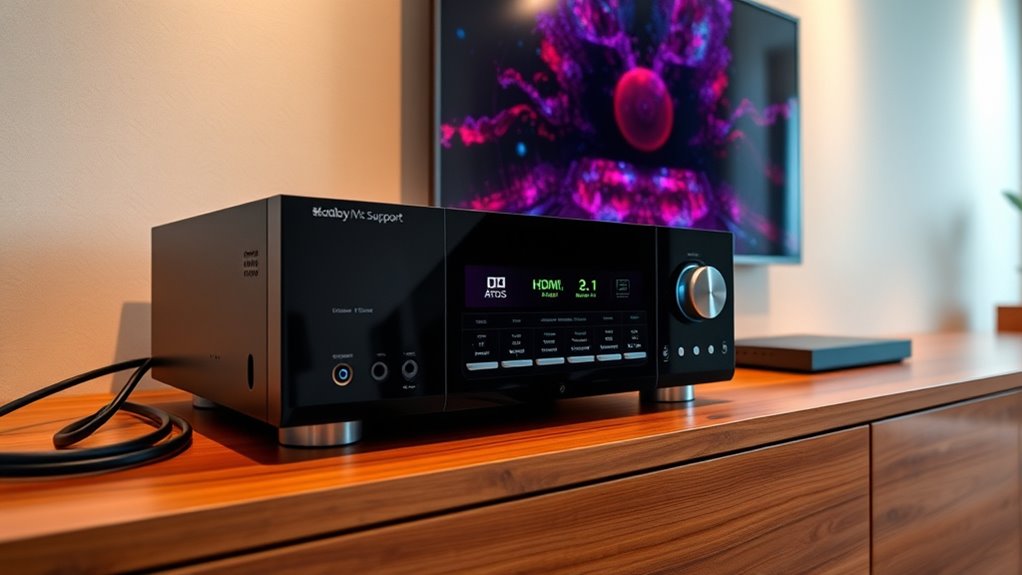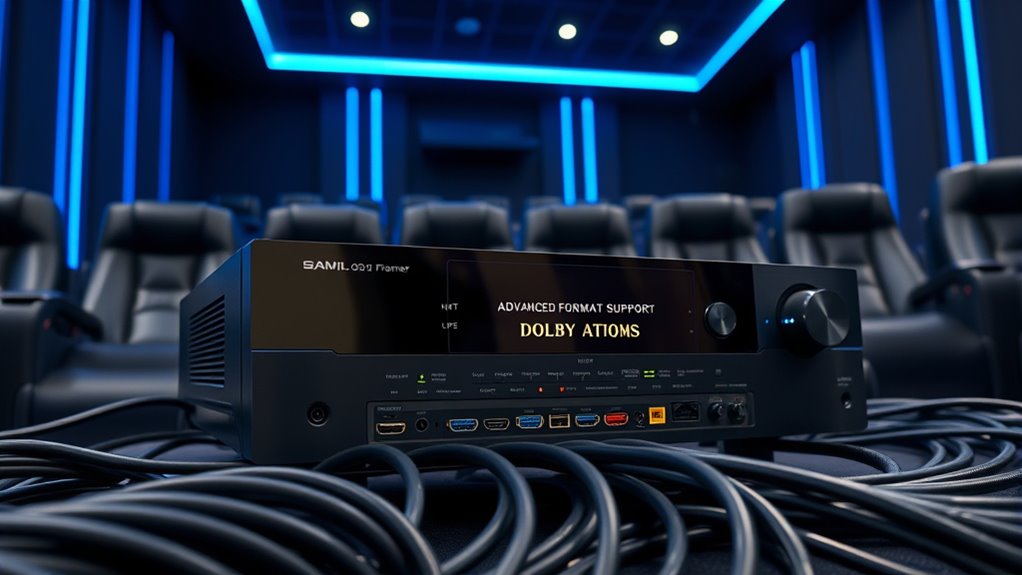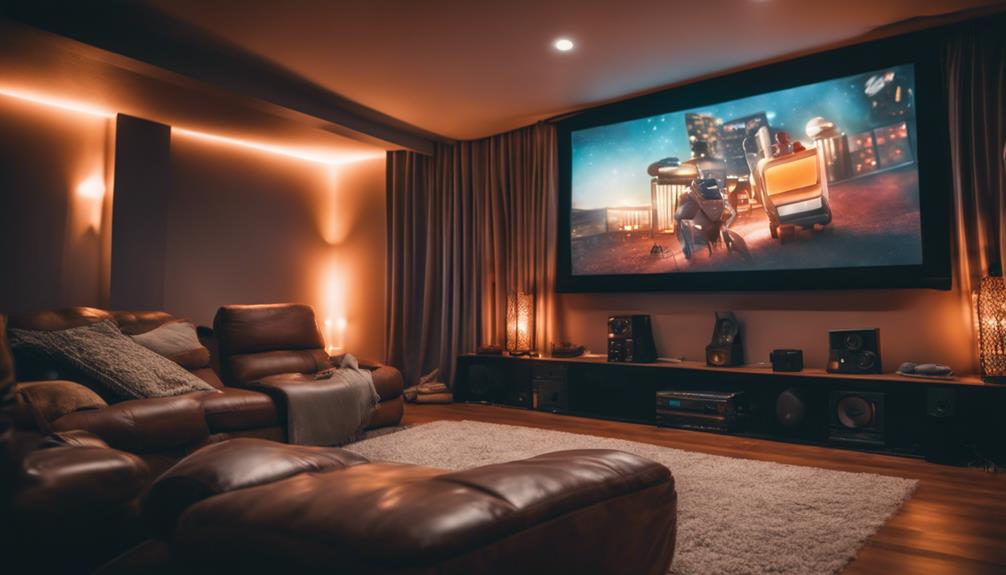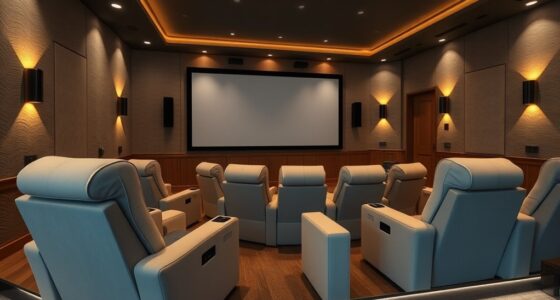Upgrading your AV receiver enables you to access the latest audio and video formats like Dolby Atmos and HDMI 2.1, giving your home theater a significant boost. It offers better sound quality, immersive 3D soundscapes, and support for 8K video with high refresh rates. Plus, new models simplify connections and future-proof your setup. If you want to learn how to maximize these features and upgrade seamlessly, keep exploring how these upgrades can transform your entertainment experience.
Key Takeaways
- Upgrade to an AV receiver supporting Dolby Atmos and DTS:X for immersive, multidimensional surround sound experiences.
- Choose a receiver with HDMI 2.1 to handle 8K resolution, high refresh rates, and advanced gaming features.
- Ensure compatibility with your existing speakers and hardware to fully utilize new audio formats.
- Look for features like eARC, VRR, and ALLM to enhance audio quality and visual performance.
- Consider future-proofing by selecting a receiver that supports the latest standards and streaming capabilities.

Upgrading your AV receiver can considerably enhance your home theater experience by delivering better sound quality, increased connectivity, and support for the latest formats. If you’re serious about getting the most out of your setup, especially with recent advancements in audio and video technology, investing in a new receiver is a smart move. Modern receivers now support advanced formats like Dolby Atmos and DTS:X, which create immersive three-dimensional sound that puts you right in the middle of the action. These formats require specific hardware capabilities, so upgrading guarantees you don’t miss out on the full cinematic experience.
One of the most significant benefits of upgrading is gaining support for Dolby Atmos, which adds height channels to create a more enveloping soundscape. Unlike traditional surround sound, Atmos allows sound to move fluidly above you, adding a layer of realism that’s especially noticeable in movies with complex sound design. To take advantage of this, you’ll need a receiver compatible with Atmos and speakers positioned accordingly, but the upgrade itself guarantees your system can handle these formats. It’s an investment that makes your home theater feel more dynamic and lifelike.
Additionally, newer AV receivers support HDMI 2.1, the latest standard for high-bandwidth connections. HDMI 2.1 offers several advantages over previous versions, including higher resolutions up to 8K, faster refresh rates (like 120Hz), and features like Variable Refresh Rate (VRR) and Auto Low Latency Mode (ALLM). These features are essential for gamers and anyone who wants the sharpest, smoothest picture possible. With HDMI 2.1, your receiver can handle the most demanding content and future-proof your setup, so you won’t need another upgrade anytime soon. Upgrading also ensures compatibility with the latest video formats and streaming standards. Supporting advanced audio formats is also crucial as it ensures you get the clearest, most immersive sound from your media.
Upgrading also brings more ports and better connectivity options, making it easier to connect multiple devices simultaneously. Many new receivers feature eARC (enhanced Audio Return Channel), which simplifies audio connections and allows for lossless audio formats like Dolby TrueHD and DTS-HD Master Audio to pass through from your TV to your receiver. This means you get higher-quality sound without cluttering your space with numerous cables. Plus, features like Bluetooth, Wi-Fi, and streaming services are often integrated, giving you more ways to access your favorite content.
Furthermore, staying current with resources and tools can help you choose the best receiver for your needs and ensure compatibility with existing equipment. Ultimately, upgrading your AV receiver guarantees compatibility with the latest formats and technologies, elevating your home theater to new heights. It’s about creating a more immersive, seamless, and future-ready entertainment environment. Whether you’re streaming 4K content, gaming at high refresh rates, or listening to the newest surround sound formats, a modern receiver makes it all possible. The investment pays off by providing richer audio, clearer visuals, and a setup that’s ready for whatever the future holds.
Frequently Asked Questions
Can My Current Speakers Support Dolby Atmos?
Your current speakers might support Dolby Atmos if they are installed on or above your main listening area and designed for height channels. However, most traditional speakers aren’t built for Atmos unless they’re specifically Atmos-enabled or Atmos-compatible. To fully experience Atmos, you’ll likely need to add upward-firing or ceiling speakers. Check your speaker specs and placement to see if they can deliver the immersive, three-dimensional sound Atmos offers.
Is HDMI 2.1 Backward Compatible With Earlier Versions?
You ask if HDMI 2.1 is backward compatible with earlier versions. Yes, it is designed to be backward compatible, so you can connect HDMI 2.1 devices to older HDMI ports. However, you won’t get the full benefits of HDMI 2.1 features unless both your source device and display support the latest standard. It’s a flexible upgrade, but check your equipment’s specs to guarantee compatibility and peak performance.
What Is the Best Budget AV Receiver for New Formats?
Think of upgrading your AV receiver as planting a seed for future tech blooms. For a budget-friendly option that handles new formats like Dolby Atmos and HDMI 2.1, consider the Sony STR-DH590 or the Denon AVR-S540BT. They’re like reliable saplings with enough growth to support your home theater dreams without draining your wallet. These models give you great sound and compatibility, helping you enjoy next-gen features today.
How Do I Connect Multiple Streaming Devices to One Receiver?
To connect multiple streaming devices to one receiver, first check how many HDMI or input ports your receiver has. Use HDMI cables to connect each device to available inputs. Then, connect the receiver to your TV via an HDMI output. Switch inputs on your receiver or remote to access each streaming device. If needed, label inputs for easy identification and seamless switching between devices.
Will Upgrading Improve My Gaming Experience Significantly?
They say, “A chain is only as strong as its weakest link.” Upgrading your AV receiver can markedly boost your gaming experience, especially with new formats like Dolby Atmos and HDMI 2.1. You’ll notice richer sound, smoother visuals, and lower latency. If your current setup is outdated, an upgrade can transform your gaming world, making every session more immersive and exciting. It’s a smart move for serious gamers!
Conclusion
Upgrading your AV receiver is like giving your home theater a fresh breath of life, opening the door to new audio and video experiences. With the latest formats like Dolby Atmos and HDMI 2.1, you’ll enjoy richer sound and sharper visuals that truly immerse you. Don’t let your system lag behind—think of this upgrade as planting the seeds for future entertainment adventures. Embrace the change and turn your living room into a cinematic sanctuary.















